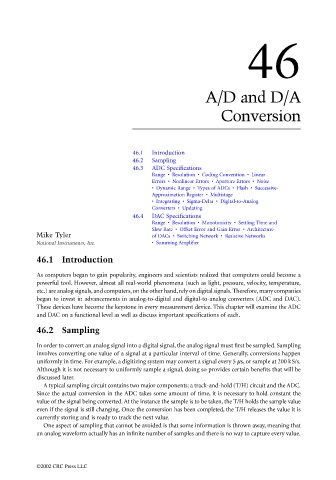Page 1185 - The Mechatronics Handbook
P. 1185
46
A/D and D/A
Conversion
46.1 Introduction
46.2 Sampling
46.3 ADC Specifications
Range • Resolution • Coding Convention • Linear
Errors • Nonlinear Errors • Aperture Errors • Noise
• Dynamic Range • Types of ADCs • Flash • Successive-
Approximation Register • Multistage
• Integrating • Sigma-Delta • Digital-to-Analog
Converters • Updating
46.4 DAC Specifications
Range • Resolution • Monotonicity • Settling Time and
Slew Rate • Offset Error and Gain Error • Architecture
Mike Tyler of DACs • Switching Network • Resistive Networks
National Instruments, Inc. • Summing Amplifier
46.1 Introduction
As computers began to gain popularity, engineers and scientists realized that computers could become a
powerful tool. However, almost all real-world phenomena (such as light, pressure, velocity, temperature,
etc.) are analog signals, and computers, on the other hand, rely on digital signals. Therefore, many companies
began to invest in advancements in analog-to-digital and digital-to-analog converters (ADC and DAC).
These devices have become the keystone in every measurement device. This chapter will examine the ADC
and DAC on a functional level as well as discuss important specifications of each.
46.2 Sampling
In order to convert an analog signal into a digital signal, the analog signal must first be sampled. Sampling
involves converting one value of a signal at a particular interval of time. Generally, conversions happen
uniformly in time. For example, a digitizing system may convert a signal every 5 µs, or sample at 200 kS/s.
Although it is not necessary to uniformly sample a signal, doing so provides certain benefits that will be
discussed later.
A typical sampling circuit contains two major components: a track-and-hold (T/H) circuit and the ADC.
Since the actual conversion in the ADC takes some amount of time, it is necessary to hold constant the
value of the signal being converted. At the instance the sample is to be taken, the T/H holds the sample value
even if the signal is still changing. Once the conversion has been completed, the T/H releases the value it is
currently storing and is ready to track the next value.
One aspect of sampling that cannot be avoided is that some information is thrown away, meaning that
an analog waveform actually has an infinite number of samples and there is no way to capture every value.
©2002 CRC Press LLC

